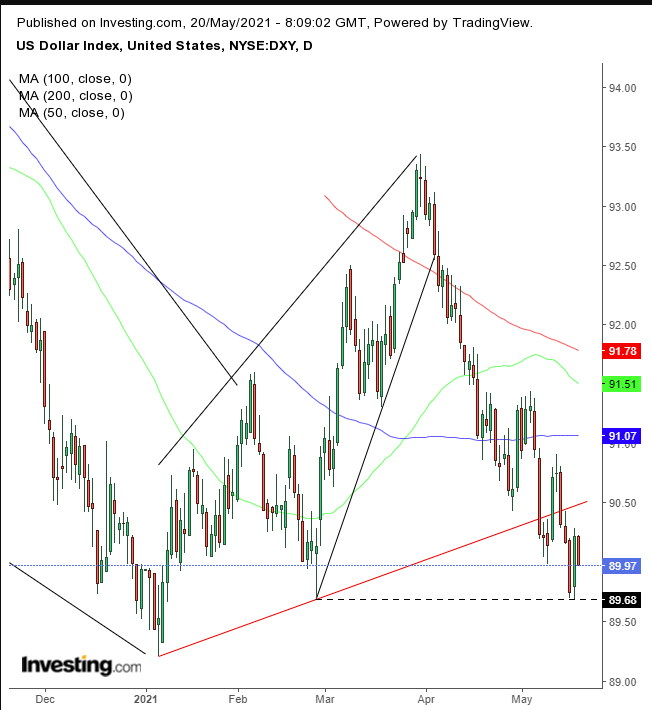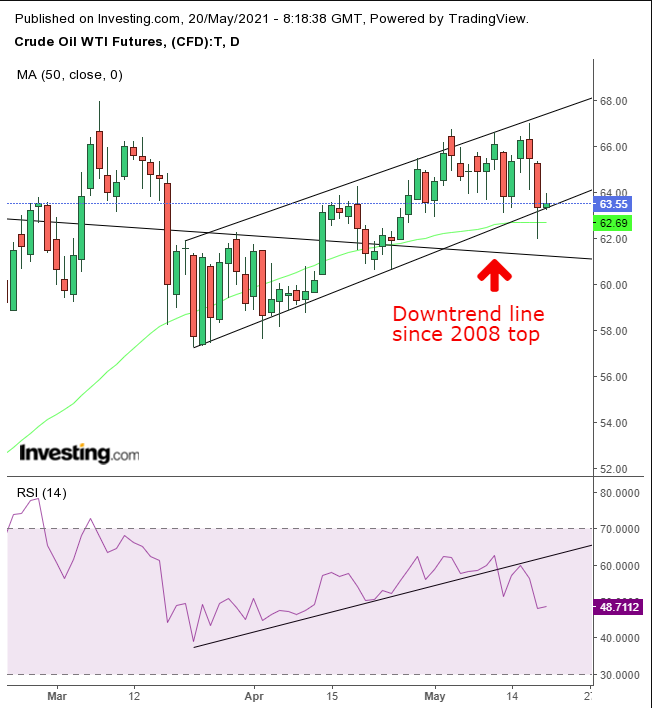- Markets remain under pressure
- Bitcoin selloff cools
- Oil finds technical support
Key Events
Futures on the Dow, S&P, NASDAQ and Russell 2000 point to another day of selling ahead of the US session open on Thursday. European shares started higher following a mixed session in Asia session as traders consider whether the pullback triggered by inflation concerns has run its course.
Bitcoin has found its footing after a collapse below $40K.
Global Financial Affairs
In Europe, the STOXX 600 opened higher with financial services and media sectors rebounding from a two-week low.
Asian markets were mixed. Japan’s government data revealed that exports increased by 38% for the month of April on a YoY basis, showing that demand for Japanese goods was rebounding from pandemic declines, and Japan’s imports climbed by almost 13%, showing strong consumer demand, even as the country faces its worst bout of the virus so far.
Nevertheless, Japan’s Nikkei 225 inched up a tepid 0.2%. It was Australia’s ASX 200 that outperformed the region, adding 1.25% of value. The drop in commodity prices—which dented the mining and energy sectors, both especially important to the Australian market—led a 1.9% slide in the Australian index on Wednesday. However, banks and the tech sector were responsible for today’s recovery.
In the US on Wednesday, the S&P 500 Index and Dow Jones Industrial Average declined for the third straight day aided by a Treasury selloff, after the FOMC minutes release disclosed that the Federal Reserve mentioned it would be open to discussing scaling back its massive bond buyiny program—“at some point.”
Tumbling commodity prices yesterday also pulled down energy and raw-material shares.
However, this morning, yields on the 10-year Treasury note fell back, weighing on the dollar and cutting yesterday’s rebound—which boosted the global reserve currency from its lowest level since the Jan. 6 bottom—in half.

The USD is testing our oft-repeated bullish call—we predicted that the currency will fall from the rising wedge completed on Apr. 6. We are waiting to see whether the wedge’s base will provide the support to continue in the uptrend, after the massive falling wedge since the 2020 peak.
We're not happy about the price’s consolidation below the uptrend line since the Jan. 6 bottom.
Gold climbed to its highest level since Jan. 7.

The yellow metal is attempting to break free of its rising channel, in order to increase its rate of ascent. However, it has found resistance for the fourth day.
Nevertheless, a recent bullish flag, an upside breakout of the falling channel since the 2020 top, including crossing above the 200 DMA, suggests that gold may continue higher, even if after a dip, along its rising channel. Note, in the medium term, gold is still in a downtrend.
After Bitcoin hit our target, having found support by the uptrend line since October, we now see a buying opportunity for the cryptocurrency.
Oil found support, even amid US/Iranian talks on reviving the nuclear deal, which may result in sanctions on Iran being lifted and a dramatic increase in crude supply.

WTI found support at the bottom of a rising channel, after the price beat the downtrend line since the 2008 peak. The RSI, however, is pointing lower.
Up Ahead
- IMF Managing Director Kristalina Georgieva and ECB President Christine Lagarde speak at the Vienna Economic Dialogue Thursday
- UK retail sales figures will be announced on Friday.
- On Friday US existing home sales figures will be published.
Market Moves
Stocks
- The STOXX 600 rose 0.6%
- The MSCI Asia Pacific Index fell 0.1%
- The MSCI Emerging Markets Index fell 0.2%
Currencies
- The Dollar Spot Index fell 0.2%
- The euro rose 0.2% to $1.2196
- The Japanese yen rose 0.2% to 109.02 per dollar
- The offshore yuan was little changed at 6.4394 per dollar
- The British pound rose 0.1% to $1.4131
Bonds
- The yield on 10-year Treasuries was little changed at 1.67%
- Germany’s 10-year yield advanced two basis points to -0.09%
- Britain’s 10-year yield advanced two basis points to 0.87%
